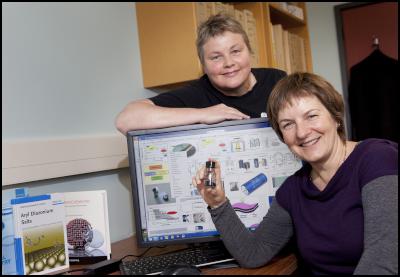UC researchers investigating greater renewable energy angles
UC researchers investigating greater renewable
energy angles for New Zealand November 4,
2013
University of Canterbury (UC) researchers are investigating energy storage devices so they can provide greater renewable energy options for New Zealand.
UC chemistry experts Professor Alison Downard and Dr Paula Brooksby have received a $739,000 Marsden fund grant to research supercapacitors energy storage devices.
They will lay the groundwork for future enhanced supercapacitor devices. Supercapacitors are currently used in situations where bursts of energy are required, such as hybrid vehicle braking systems and defibrillators.
``Renewable energy sources are playing an increasing role in meeting the global energy demand,’’ Professor Downard says.
``To fully exploit renewable energy sources such as wind and solar, efficient and cost-effective energy storage is essential because renewable energy is not necessarily generated at the place and time when we need it, so storage is required.
``Current energy storage capabilities have to be improved to match the advance in renewable energy generation. Supercapacitors can be part of the energy storage solution.
``Compared with batteries, existing supercapacitors have low energy density, but they can be very rapidly recharged and have long charge-recharge lifetimes.
``The energy density of a super-capacitor is directly dependent on the area of its electrodes. The key to increasing the storage capability of supercapacitors is maximising the area of electrodes.
``Graphene, a super-thin single layer of graphite, has the highest theoretical capacitance of any material and so is ideal for constructing supercapacitors.
``The problem with graphene is that the sheets clump together and so most of its surface area is lost. The challenge is to prevent the sheets clumping together and to arrange them in a way that maximises the capacitance (electrical charge storage).
``We have designed novel strategies for stacking carefully spaced graphene sheets upright on electrode surfaces. We can tune the spacing between sheets so we can maximise the capacitance.’’ Professor Downard says.
Their research will be carried out over the next three years and by 2017 UC will have its new $212 million Regional Science and Innovation Centre where the Chemistry Department will be based.
The Government last week announced a $260 million support for UC which included funding for the new science centre.

Professor Alison downward (seated) and Dr Paula Brooksby
ENDS


 Thrive Whanganui: Empowering Entrepreneurs With Disabilities - Launching February 2025
Thrive Whanganui: Empowering Entrepreneurs With Disabilities - Launching February 2025 Primeproperty Group: Primeproperty Group Purchases The Reading Cinema Complex & Adjoining Car Parking Properties in the heart of Wellington's Courtenay Place
Primeproperty Group: Primeproperty Group Purchases The Reading Cinema Complex & Adjoining Car Parking Properties in the heart of Wellington's Courtenay Place Hugh Grant: Lessons From Australia - How Digital Tools Could Support NZ Nurses In Palliative Care
Hugh Grant: Lessons From Australia - How Digital Tools Could Support NZ Nurses In Palliative Care Canterbury Museum: Dinosaur Dolphins Survived In New Zealand Long After Extinction Elsewhere
Canterbury Museum: Dinosaur Dolphins Survived In New Zealand Long After Extinction Elsewhere Retail NZ: Retailers Still Under Pressure At End Of 2024
Retail NZ: Retailers Still Under Pressure At End Of 2024  University of Canterbury: Research Sheds Light On Fire Risk For Canterbury
University of Canterbury: Research Sheds Light On Fire Risk For Canterbury



